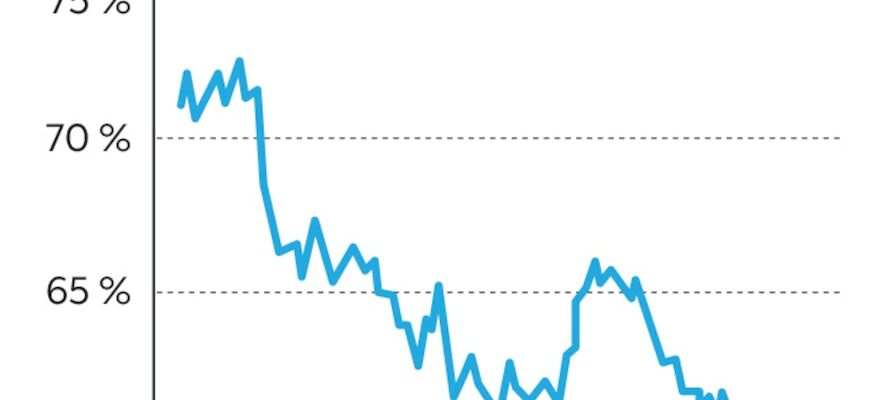First there is the location. Symbolic. Kazan, the capital of Tatarstan, showcase of Putin’s Russia, the icy waters of the Volga in the background. And then Vladimir Putin’s guest list: Chinese President Xi Jinping, Indian Narendra Modi, Turkish Recep Tayyip Erdogan, Iranian Massoud Pezeshkian. In all, around twenty heads of state, gathered for three days – from October 22 to 24 – for the traditional Brics summit.
A flashy family photo to immortalize this informal meeting between leaders of countries that can less and less be described as “emerging”. Together, they represent nearly 30% of global GDP. What do they have in common? At best, annoyance with “Western imperialism”. At worst, a hatred of democracy. Their war is not just geopolitical or military. It is also economic, targeting the dollar, an instrument of American power.
The angle of attack is not new. Since 1971 and the burial of the Bretton Woods agreements, which marked the end of the gold convertibility of the dollar, the pythians have succeeded one another to predict the fall of the greenback. After all, the American fortress was going to eventually fall, since over the decades America’s weight in world production eroded, going from nearly 27% at the start of the 1970s to just under 16% today. ‘today. In the 1980s, the yen was seen, for a time, as a possible challenger as Japan bought up all of Hollywood.
Then, at the turn of the 2000s, some imagined that the young euro could steal its crown as the international reserve currency from the greenback. Except that a currency without a State is a bit like a chicken without its head. Today, China also dreams of being on an equal footing with the United States. “Slowly, a form of yuan zone is taking shape in South Asia while certain currencies in the region such as the Thai baht or the Malaysian ringgit now follow the ups and downs of the Chinese currency more than those of the greenback,” notes Stéphane Déo, economist and investor at Eleva Capital. Since 2018, an oil exchange has also emerged in Shanghai where black gold is quoted in yuan. But the volumes exchanged remain lilliputian. “The strength of a currency lies in the confidence it inspires. And on this level, the United States is still a long way ahead of China, whose monetary and financial system is very opaque,” says Gaetano Gaballo, professor at HEC.
The fortress of the greenback has certainly cracked but the walls remain solid. A study by the International Monetary Fund published last July reveals that the dollar still represents 60% of central banks’ foreign currency reserves compared to nearly 70% at the start of the century. A decline – undeniable – but which did not benefit any currency in particular. Certainly, the yuan has climbed a few places but other dollars such as those of Canada, Australia or Singapore have also gained weight. “Until now, the hegemony of the greenback has been barely undermined,” summarizes Barry Eichengreen, professor at the University of Berkeley.
Share of the dollar in central banks’ foreign exchange reserves (in percentage).
© / THE EXPRESS
The dollar, a political machine
A large part of world trade is still denominated in dollars, as is the majority of borrowing in emerging countries’ currencies. Within interbank transactions recorded by the Swift system, the weight of the currency has even increased in recent years to the detriment of the euro. Almost the majority of raw materials, particularly those considered strategic, are quoted in dollars. And the capitalization of the New York Stock Exchange alone still represents half of the world stock market valuation…
“The dollar is a political machine entirely at the service of American power,” observes Marc Flandreau, professor of economic and financial history at the University of Pennsylvania. At the heart of this machine, an arsenal of financial and economic sanctions which hover over all companies, individuals, associations or NGOs on the planet. An extremely complex but terribly effective system, with a barbaric name: the extraterritoriality of American law.
It is enough to have used the dollar one day to pay an invoice to an entity placed on Washington’s blacklist to be caught by the American patrol. And even if the invoice is in euros or Swiss francs, there will always be a bolt or software paid in dollars in the accounts. Ten years ago, BNP Paribas was fined $8.9 billion for attempting to conceal its involvement in transactions with countries placed under sanctions by Washington, notably Iran, Sudan and Cuba. . A weapon powerful enough for all major Western companies to obey with their finger on the seam, for fear of being denied access to the American market.
A monetary cold war
Aware of the danger, certain countries are today trying to de-dollarize their economies in order to immunize themselves against possible American sanctions. Russia, whose central bank’s foreign currency reserves were almost entirely frozen following the invasion of Ukraine, has made the switch at a rapid pace. Three quarters of the country’s trade is now denominated in rubles or yuan compared to only a fifth before the start of the war.
“Today, half of China’s trade is done in yuan,” underlines Agathe Demarais, senior economist at the European Council on Foreign Relations. To go even further, in Kazan, Russia, the Brics leaders drew up the outline of a new global financial architecture – the Brics Bridge, a rival to Swift – based on state cryptocurrencies which would escape American channels and the surveillance from Washington. “As if a sort of financial cold war was being prepared with a world separated between two camps, each with its own currency, its own exchange systems and its own rules of the game,” anticipates Marc Flandreau. A fragmentation of the world that will take decades. But the little seeds of this revolution have been sown.
.
